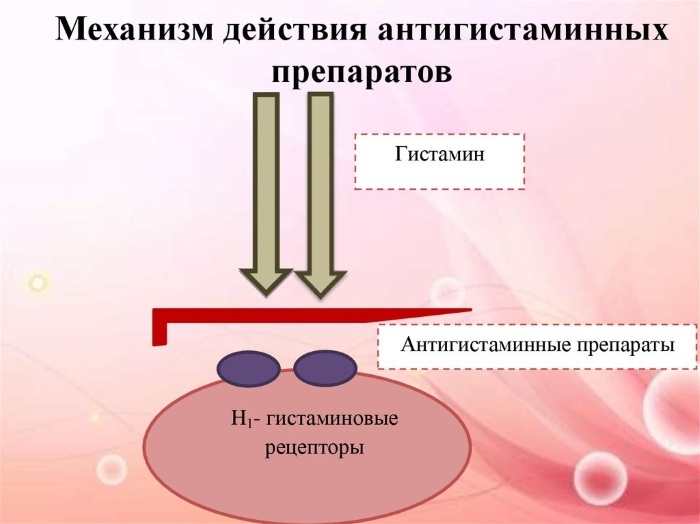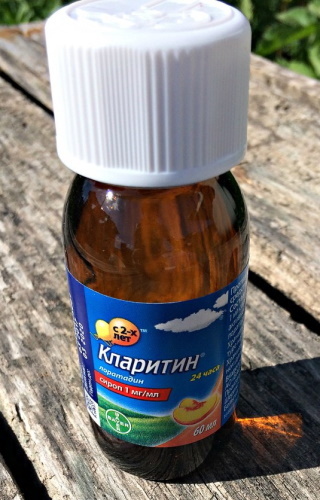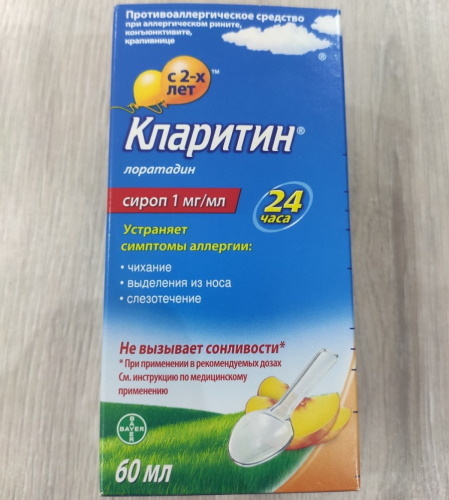Content
- Release form
- Chemical composition
- Pharmacological properties
- Pharmacodynamics and pharmacokinetics
- Indications for use
- Contraindications
- At what age can the drug be used?
- Instructions for use, dosage
- Side effects
- Overdose
- special instructions
- Drug interactions
- Analogs
- Terms, conditions of sale and storage
- Price
- Claritin video
Claritin syrup is a drug for children and adults, which is produced by the Belgian pharmaceutical company Schering Plow Labo. This drug belongs to the pharmacological group of histamine-sensitive H1 receptor blockers.
Claritin is prescribed for the complex and symptomatic treatment of food, seasonal, drug allergies. The dosage regimen for this drug depends on the patient's age and body weight.
Release form
Claritin for children is produced in the form of a colorless syrup, which looks like a thick transparent liquid with a yellowish tinge. The composition of this product should not contain crystalline particles or signs of sediment. Stratification of the drug into fractions indicates a change in its biochemical composition, or a violation of storage conditions.
The antiallergic agent is bottled in glass bottles made of dark brown glass. The vial capacity is 60 ml or 120 ml. Each bottle of Claritin syrup is equipped with a convenient plastic spoon for pouring therapeutic doses. The main packaging of the drug is a cardboard box, inside which contains detailed instructions for the use of this medication.
Chemical composition
Claritin is a syrup for children, the active ingredient of which is loratadine at a dosage of 1 mg. The table below lists the excipients that make up 1 ml of this medication.
| Chemical component name | Purpose and dosage |
| Water | Sterile water, purified from mineral impurities, acts as a solvent for the constituent components of this drug. Mass fraction of this substance is up to 1 ml. |
| Lemon acid | Safe preservative that prolongs the shelf life of this medication. The concentration of citric acid in the Claritin baby syrup is 9.6 mg. |
| Flavoring | A synthetic chemical that imbues the drug with a peach scent. This component is presented in a dosage of 2.5 mg. |
| Granular sucrose | It is used as a preservative and also gives the syrup a pleasant sweet taste. Mass fraction of this substance is 600 mg. |
| Glycerol | Provides uniform mixing of all components that are part of this drug, and also prevents their stratification into separate fractions. The concentration of glycerol does not exceed 100 mg. |
| Sodium benzoate | A chemical preservative that maintains the sterility of the syrup throughout its shelf life. The dosage for sodium benzoate is 1 mg. |
Claritin syrup contains a small amount of chemical components. This medication is completely safe for the child's body. Additional substances included in its composition create a minimum load on the tissues of internal organs.
Pharmacological properties
Claritin is a syrup for children, which is used as the main or auxiliary agent for the treatment of an allergic reaction.
This medication has pharmacological properties:
- removes signs of an allergic reaction;
- inhibits the sensitivity of H1 receptors to the release of large volumes of histamine into the bloodstream;
- relieves swelling of the mucous membranes, which has arisen under the influence of external and internal allergens;
- allows you to get rid of rhinitis, lacrimation, bronchial spasm, provoked by acute or chronic allergies.
A distinctive feature of Claritin syrup is that its fast therapeutic effect is combined with a prolonged action of the active substance. Compliance with the prescribed dosage regimen with this medication does not lead to a slowdown in psychomotor reactions or a direct effect on the functions of the child's central nervous system.
Pharmacodynamics and pharmacokinetics
Pharmacodynamics of Claritin syrup is manifested by selective blocking of peripheral H1 receptors, which are responsible for the identification of histamine. The pharmacological action of this drug is due to the biochemical properties of its main substance in the form of loratadine.

This component is a tricyclic compound with a rapid antihistamine effect on the body. Loratadine is not able to cross the blood-brain barrier, does not have a direct effect on the centers of the brain. Unlike most other antiallergic drugs, Claritin children's syrup does not show the effect of sedation, and also does not cause constant drowsiness.
Long-term therapy with Claritin in patients who suffer from allergic reactions does not cause significant changes in the work of their internal organs. This fact is confirmed by the results of laboratory studies of this medication and the diagnostic conclusions of patients. Loratadine does not show a selective effect on the functional activity of histamine-H2 receptors. After taking therapeutic doses of this medication, there is no reuptake of the norepinephrine substance, and there is also no effect of the active component on the work of the cardiovascular system.
The therapeutic effect of Claritin syrup begins after 30 minutes. after taking a single dose. A stable antihistamine effect of this medication is achieved after 8-12 hours from the start of treatment. The duration of action of loratadine is at least 24 hours. After a specified period of time, the patient needs to re-take the therapeutic dose.
Otherwise, the signs of an allergic reaction may reappear. For example, if the child continues to come into contact with sources of allergens. At the same time, even long-term treatment with this drug does not cause drug dependence.
The pharmacokinetics of Claritin syrup begins to appear in the first minutes after using this agent. Once in the gastrointestinal tract, loratadine is rapidly absorbed into the intestinal walls, saturating the composition of the patient's bloodstream. The maximum concentration of this substance in plasma is reached 1.5-2 hours after a single dose of an antiallergic drug. Concomitant food intake slows down the absorption of syrup in the organs of the digestive system.
The main metabolite of the drug Claritin is the substance desloratadine, which is formed in the liver tissues after 60 minutes. after taking a standard therapeutic dose. The bioavailability of this component has a dose-dependent effect.
The active substance of Claritin syrup forms strong molecular bonds with blood plasma proteins. This figure averages 97-99%. During the metabolic conversion of loratadine to the chemical compound desloratadine, isoenzymes CYP2D6 and CYP3A4 are used.
About 40% of the decay products of the drug Claritin are excreted by the kidneys in the urine. Another 42% of metabolites are utilized from the body along with feces. The main burden of cleansing the blood from loratadine and its chemical by-products falls on the organs of the excretory system. Pharmacodynamics of Claritin syrup is manifested in the same way in relation to the body of children of different age groups.
Indications for use
Claritin is a syrup for children, which is indicated for use to get rid of the following symptoms of a chronic and acute allergic reaction:
- idiopathic urticaria;
- burning in the eyes;
- various kinds of dermatitis and other skin irritations caused by individual intolerance to certain substances;
- itching of mucous membranes and epithelial tissues;
- sneeze;
- allergic rhinitis with seasonal and year-round manifestations;
- lacrimation resulting from contact of the mucous membrane of the eyes with potential allergens (pollen from trees and flowers, household dust, molds, animal hair, feathers and down of birds).

Claritin is prescribed as a maintenance therapy. This medication can significantly reduce or completely eliminate the negative reaction of the body in response to the pathogenic effects of allergens. Claritin syrup is most effective in the treatment of patients with mild to moderate form an allergic reaction without signs of severe complications, disturbances in the work of internal organs and systems life support.
Contraindications
Claritin syrup is categorically contraindicated for use in the following cases:
- the age of the child is under 2 years old;
- hypersensitivity of the child's body to the active substance of the antiallergic agent in the form of loratadine (in this case, an increase in the symptoms of an already existing allergic reaction is possible);
- congenital lactase deficiency;
- chronic deficiency of isomaltase or sucrase;
- the state of pregnancy;
- hereditary or acquired galactose intolerance.
The antiallergic drug Claritin in the form of a syrup is prescribed with extreme caution to children who have been diagnosed with severe liver pathologies. During the metabolism of loratadine, an additional load is created on the functions of this organ. In this regard, an exacerbation of an existing liver disease is possible.
At what age can the drug be used?
Claritin in the form of a syrup is indicated for use in symptomatic and course therapy in children over 2 years of age. This drug is not used to treat younger patients. Elderly patients do not need to establish a special dosage regimen.
Instructions for use, dosage
Claritin is a syrup for children, the doses of which are selected individually, depending on the age of the child and his total body weight. Patients in the age category from 2 to 12 years old take 1 tsp. l. (5 ml) of the drug once a day. This is provided that the child's body weight is less than 30 kg. Children of the same age, who weigh more than 30 kg, should drink 2 hours once every 24 hours. l. Claritin (10 ml).
Patients over 12 years of age and adolescents take Claritin at a dosage of 2 hours. l. Once a day. Patients with chronic renal and hepatic insufficiency who suffer from bouts of allergic reactions need to reduce the therapeutic dose of this drug. Patients in this category take Claritin syrup in a dosage of 1-2 hours. l. in one day. Throughout the course of therapy, the functional state of the kidneys and liver of the child is monitored. The duration of treatment is determined by a pediatrician or pediatric allergist.
Side effects
During the course or symptomatic therapy with Claritin syrup, the occurrence of individual sensitivity of the body to the active substance of the drug, loratadine, is not excluded.
In this case, the child may experience the following symptoms:
- the appearance of a red or pink rash with its localization in different parts of the skin;
- heart rhythm disturbances;
- dizziness;
- rapid fatigue and loss of physical strength;
- nausea;
- inflammation of the mucous membrane of the walls of the stomach, which is manifested by typical signs of gastritis;
- cramping pain inside the abdominal cavity;
- urticaria, accompanied by itching of the skin;
- vomit;

- decreased or complete loss of appetite;
- increased irritability, nervousness;
- insomnia;
- increased appetite;
- drowsiness and slowing down of psychomotor reactions;
- deterioration in the functional state of the liver;
- loss of scalp;
- dryness of the oral mucosa;
- anaphylactic shock, which is the most severe form of allergic reaction (this side effect of loratadine can be fatal);
- tachycardia attacks, which are combined with shortness of breath;
- Strong headache.
The appearance of the above side effects of the drug Claritin is the basis for the termination of further therapy with this syrup. A child with signs of individual intolerance to loratadine should be examined by a pediatrician. To stop the attacks of an allergic reaction, a course intake of antihistamines based on other active substances is prescribed.
Overdose
Violation of the prescribed dosage regimen can lead to intoxication of the child's body with the active ingredient loratadine and its metabolites.
In case of an overdose with Claritin syrup, the following symptoms are observed:
- constant sleepiness;
- heart palpitations;
- decreased physical activity;
- loss of appetite;
- Strong headache;
- nausea;
- vomit.
The onset of the last two symptoms occurs in situations where, through negligence or oversight on the part of the parents, the child drank too much syrup in bottle. Patients with signs of Claritin overdose are hospitalized in the pediatric or toxicology department.
The child receives symptomatic therapy, which includes an algorithm of actions:
- Gastric lavage with further induction of vomiting to remove residual syrup from the digestive system, which has not yet had time to be absorbed into the intestinal walls.
- Organization of a drinking regime, which provides for the intake of crushed activated carbon added to ordinary water without gases.
- Restoration of the patient's electrolyte balance, which was disturbed due to intestinal upset and vomiting.
A child with symptoms of an overdose of Claritin syrup remains in the hospital of a medical institution until the general condition is completely stabilized. The patient must be under round-the-clock supervision by medical personnel. Loratadine is not excreted from the child's body through hemodialysis or any other methods. The removal of the active substance of the syrup is carried out only by washing the stomach, and the already absorbed medication is excreted by the kidneys. Therefore, it is very important that during the entire recovery period the child is provided with clean water without gases.
special instructions
Children who undergo a diagnostic examination in the form of allergic tests to determine irritant factors should stop taking Claritin syrup 48 hours before visiting the clinic. Otherwise, the active substance of the antihistamine will affect the test results. It is possible to obtain distorted laboratory diagnostic data. Claritin syrup is best suited for the treatment of children aged 2 to 3 years.
The constituents of this drug do not have a negative effect on the centers of the brain, which are responsible for the speed of psychomotor reactions and concentration of attention. Therefore, taking this medication does not affect the child's performance in school.
During clinical trials of Claritin syrup, in very rare cases, individual patients complained of slight drowsiness, decreased performance. Such symptoms may indicate the manifestation of side effects caused by loratadine. If, after starting to take the syrup, the child begins to complain that he wants to sleep all the time, he began absent-minded, cannot collect thoughts, then this fact must be immediately reported to a pediatrician.
Drug interactions
The drug interaction of Claritin syrup is due to the biochemical activity of its active ingredient. In the case of the simultaneous administration of this medication with the drugs Erythromycin, Cimetidine, and Ketoconazole, the concentration of loratadine in the blood plasma increases.
An increase in the concentration of the active substance in the patient's body does not cause disturbances in the work of his internal organs and life support systems. The only exceptions are children with renal and hepatic insufficiency. Patients in this category should be under the constant supervision of a doctor. Claritin syrup does not enhance the effect of ethyl alcohol-based drugs on the central and peripheral nervous system.
Analogs
The table below lists the main antihistamines that contain the active substance loratadine, and are also analogues of Claritin syrup.
| The name of the anti-allergic agent | Average cost in pharmacies |
| Claridol (India) | 181 r |
| Loratadin Teva (Hungary) | 152 RUB |
| Loratavel (Russia) | RUB 161 |
| Clarisens (Russia) | 94 r |
| Lomilan (Slovenia) | 129 RUB |
| Loragexal (Germany) | RUB 49 |
The above medications for the treatment of seasonal and year-round allergies should be prescribed exclusively by the treating person. by a pediatrician after a preliminary examination of the child, as well as identification of potential sources irritation.
Terms, conditions of sale and storage
Sale of Claritin syrup is carried out without presenting a prescription from the attending physician. The shelf life of this drug is 3 years. During this period of time, the antiallergic agent should be used for its intended purpose. After the expiration date, the syrup bottle is disposed of.

Storage of the drug Claritin is carried out in a room with an air temperature not higher than +25 degrees Celsius.
Price
The average cost of 1 bottle of 60 ml with Claritin syrup in retail pharmacy chains ranges from 60 to 125 rubles.
Claritin syrup is an antihistamine for the treatment of an allergic reaction in children from 2 years of age. This drug is used for the purpose of symptomatic therapy, or it is included in the general course of treatment for a set period of time.
The main component of this medication is the substance loratadine. The advantage of treatment with Claritin syrup is that to relieve the symptoms of an allergic reaction, it is enough to take 1-2 hours. l. drug only 1 time per day. The antiallergic agent of this form of release has a pleasant peach aroma, which does not cause any protest against taking the medicine in children of the younger age group. Long-term therapy with Claritin syrup does not have a sedative effect and does not cause drug dependence.
Claritin video
Claritin syrup description and instructions:



